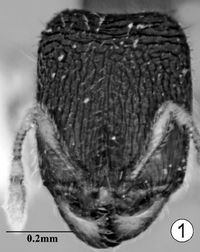Carebara mukkaliensis
| Carebara mukkaliensis | |
|---|---|

| |
| Scientific classification | |
| Kingdom: | Animalia |
| Phylum: | Arthropoda |
| Class: | Insecta |
| Order: | Hymenoptera |
| Family: | Formicidae |
| Subfamily: | Myrmicinae |
| Tribe: | Crematogastrini |
| Genus: | Carebara |
| Species: | C. mukkaliensis |
| Binomial name | |
| Carebara mukkaliensis Bharti, Akbar & Aldawood, 2014 | |
The type material was collected from leaf litter of approximately 2 cm thickness. The study area is situated at an altitude of 897 meters. It is a shady place with minimum of sunlight penetration. Mean annual temperature is 20.2 °C. Average annual rainfall is 6,066 mm with 95% relative humidity. It is a primary undisturbed tropical moist evergreen forest. (Bharti et al. 2014)
Identification
Bharti et al. (2014) - C. mukkaliensis somewhat resembles to the Chinese Carebara obtusidenta but can be easily distinguished from the latter. In case of C. mukkaliensis cephalic dorsum is strongly and uniformly sculptured throughout, posterodorsal corner of propodeum bluntly angled, eyes consists of 2–3 ommatidia, masticatory margin of mandible is having 4-teeth, metanotal groove is deeply impressed and petiole with straight ventral face; anteroventral corner is not dentate whilst in case of C. obtusidenta cephalic dorsum is having anterior and posterior portions more sculptured, propodeum with a pair of rightly angled teeth, eyes consisting of single ommatidium, masticatory margin of mandibles with 5-teeth, metanotal groove is less deeply impressed and petiole with concave ventral face; anteroventral corner acutely dentate. C. mukkaliensis also shares some affinities with Carebara wheeleri. However, the two species can be easily separated. In case of C. mukkaliensis anterior margin of clypeus is deeply concave, posterior cephalic margin with small, acute spines, eyes consists of 2–3 ommatidia and mesosoma uniformly punctuate throughout whilst in case of C. wheeleri anterior margin of clypeus is straight, posterior cephalic margin with well prominent upcurved spines, eyes consists of single ommatidium and mesosoma shagreened or reticulate.
Keys including this Species
Distribution
Distribution based on Regional Taxon Lists
Oriental Region: India (type locality).
Distribution based on AntMaps
Distribution based on AntWeb specimens
Check data from AntWeb
Countries Occupied
| Number of countries occupied by this species based on AntWiki Regional Taxon Lists. In general, fewer countries occupied indicates a narrower range, while more countries indicates a more widespread species. |

|
Estimated Abundance
| Relative abundance based on number of AntMaps records per species (this species within the purple bar). Fewer records (to the left) indicates a less abundant/encountered species while more records (to the right) indicates more abundant/encountered species. |

|
Biology
Castes
Nomenclature
The following information is derived from Barry Bolton's Online Catalogue of the Ants of the World.
- mukkaliensis. Carebara mukkaliensis Bharti & Akbar, 2014b: 315, figs. 1-3 (s.) INDIA (Kerala).
- Type-material: holotype major worker, 4 paratype major workers.
- Type-locality: holotype India: Kerala, Silent Valley Nat. Park, 11°5’N, 76°26’E, 897 m., 26.ix.2011, Winkler (S.A. Akbar); paratypes with same data.
- Type-depositories: PUAC (holotype); BMNH, CASC, PUAC (paratypes).
- Status as species: Bharti, Guénard, et al. 2016: 34; Akbar & Bharti, 2017: 38 (in key).
- Distribution: India.
Description
Worker
Major. (holotype in brackets): HL (0.61)-0.63, HW (0.48)-0.49, SL (0.23)-0.25, ED (0.04)-0.05, ML (0.14)-0.15, MSL (0.41)-0.44, PW (0.22)-0.25, PTL (0.14)-0.16, PPTL (0.11)-0.14, PTW (0.12)-0.15, PPTW (0.11)-0.13, PTH (0.11)-0.14, PPTH (0.08)-0.10, HHL (0.01), CI 77-(78), SI (47)-51, EI (8)-10 (n = 5).
Head longer than broad, rectangular in full face view. Occipital margin transverse to slightly concave in the middle with occipital corners gently roundly, lateral sides slightly convex. Mandible with 4-teeth. Median portion of clypeus longitudinally depressed, bicarinate and divergent forward, anterior margin strongly concave. Antennae 9-segments with a 2-segmented club, scapes short and clavate; reaching up to 1/2 of posterior margin of head. Eyes with 2–3 ommatidia. In profile view, vertex with a pair of small well developed acute horns. Dorsum of head straight.
Promesonotum high and roundly convex. Promesonotal suture obsolete on the dorsum. Metanotum obsolete. Metanotal groove deeply impressed. Propodeum with a pair of protruding dents, dorsum straight and truncate, declivity straight without thin lateral laminae. Petiole pedunculate anteriorly. Petiole node cone shaped with thick anterior and posterior faces. Postpetiole node roundly convex and lower than petiolar node. In dorsal view postpetiolar node as broad as petiolar node.
Mandibles and clypeus smooth and shiny. Head finely and longitudinally striate throughout. Transverse striations present on dorsum of occipital lobes and between vertexal horns, with lateral sides having rugose-reticulations. Mesosoma, petiole and postpetiole uniformly punctuate throughout. Gaster smooth and shining.
Head and body with abundant erect to suberect hairs. Scapes and tibiae with dense decumbent pubescence.
Body dark yellowish in colour.
Type Material
Holotype (major worker) and 4 paratypes (major worker): INDIA: Kerala, Silent Valley National park, 11°5`N, 76°26`E, 897m, 26.ix.2011, Winkler method (coll. Shahid A. Akbar). Holotype and paratype in Punjabi University Ant Collection; one paratype will be deposited in The Natural History Museum and one in California Academy of Sciences.
Etymology
The species is named after its type locality Mukkali, part of Silent Valley National Park.
References
References based on Global Ant Biodiversity Informatics
- Bharti H., and S. Ali Akbar. 2014. New additions to ant genus Carebara Westwood (Hymenoptera: Formicidae: Myrmicinae) from India. Acta Zoologica Academiae Scientiarum Hungaricae 60(4): 313324.
- Dad J. M., S. A. Akbar, H. Bharti, and A. A. Wachkoo. 2019. Community structure and ant species diversity across select sites ofWestern Ghats, India. Acta Ecologica Sinica 39: 219–228.

